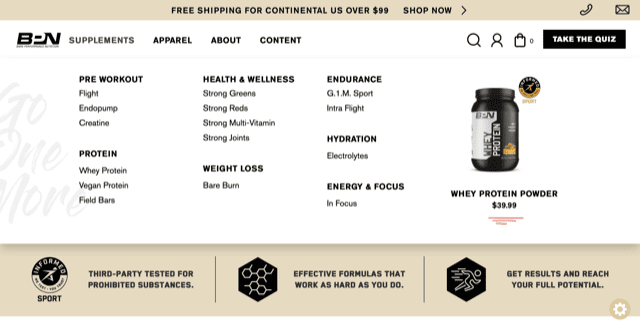
This year, holiday season ecommerce sales are projected to reach $206.88 billion. That’s a staggering figure, and with so much potential on the table, your ecommerce store can capitalize on the rush to buy.
Despite this opportunity, there are a few places where ecommerce stores can stumble and jeopardize their sales. If you’re not careful, three digital Grinches will ruin your holiday by affecting your sales volume. Cybersecurity risks, slow websites, and non-personalized content will all impact your ecommerce sales. But don’t worry — in this guide, we’ll show you exactly how to banish these Grinches and enjoy healthy sales this holiday season.
Table of Contents
Grinch #1: Cybersecurity Risks

Cyberattacks are a major threat to ecommerce businesses. IBM found that the average cost of a data breach in 2021 is $4.24 million. Most businesses don’t have the financial bandwidth to deal with that level of devastating loss.
But it’s not just financial stress. A cyberattack that compromises your customers’ data will tank your reputation. After working to build a strong relationship with your clients, one attack or breach can ruin years of effort. Customers will no longer trust you or be willing to shop with you, which could cause your ecommerce sales to suffer.
And the worst news? Cybersecurity attacks are on the rise. Each day, over 30,000 websites are hacked worldwide. After the pandemic forced millions of people to shift to working from home, companies’ security got a lot more complicated. Securing your office is one thing, but how can you ensure your network and customer data are secure when employees are using their own devices or unsecured WiFi?
Most ecommerce merchants aren’t prepared for cyberattacks. They don’t have a plan in place to prevent, mitigate, or recover from cybersecurity risks. If you’re not ready, you could find yourself deep into Q4 and the holiday season with a downed website and low ecommerce sales.
Grinch #1 Solution: Invest in Cybersecurity Training and Protocols
Training
In cybersecurity, your system is only as strong as your weakest link. And that weak link is usually us. We’re all human, and we make mistakes. The best line of defense you can take against cyberattacks is training your employees in best practices for preventing and identifying potential attacks or breaches.
To start, train work-from-home (WFH) employees on how to secure their home network. You may need to invest in additional tools and services to ensure your network is protected across every point, including employees’ homes. Educate employees on why mixing devices for work and personal use is a bad idea, and provide recommendations for how you’d like employees to use their approved devices. All employees will need to know about strong password management and how to identify phishing email scams.
Protocols
Cybersecurity protocols are guidelines that experts, governments, or overseeing authorities have put into place to help prevent cyberattacks. Following these protocols will ensure you have the lowest chance of exposing your ecommerce sales and business to breaches.
PCI DSS
The PCI DSS (Payment Card Industry Data Security Standard) was created to help merchants protect their customers’ sensitive credit card information. These standards outline how to safely store and transmit credit card data online. If you don’t adhere to these guidelines, your business could face fines or penalties, like losing your merchant account.
TLS and SSL
TLS (Transport Layer Security) and SSL (Secure Sockets Layer) protect encrypted data moving between networks. You can get an SSL certificate for your ecommerce store to assure visitors that their data is safe.
MFA
MFA (multi-factor authentication) is a method of verifying the identity of customers trying to log in to your ecommerce store. Requiring users to provide multiple forms of authentication reduces the chance of fraud.
GDPR
GDPR (General Data Protection Regulation) is a data protection standard active in the EU. All businesses that sell to customers in the EU must abide by this standard. In the US, more states are beginning to implement similar data protection standards. Be sure to research which standards you need to follow in your ecommerce sales business.
Limited Access
Constantly monitor who has access to your network, website, and customer data. Former employees, contractors, and clients may have more access than you realize. Regularly audit your user list to ensure only approved users can access sensitive data. And don’t stop at your website. Breaches can happen through apps and extensions, too.
Enhancing Security for Clients
“Ensure that your site theme and extensions are up to date. WordPress is the most popular CMS in the world, which also makes it a popular target for hackers. To combat malicious attacks, WordPress regularly releases security updates. It’s recommended to keep your WordPress version up to date and install high-rated plugins that are regularly updated by developers. If you have premium plugins installed on the site, keep the license active so you can receive the updates. For enhanced security, refrain from using “admin” as your username and keep a strong password for your WP admin login. Security plugins, like WordFence and Sucuri, may also take your site’s security to the next level.
For SaaS platforms like BigCommerce and Shopify, security breaches are still possible through loopholes in their security platforms. For example, most of the security issues are caused by third-party apps, malicious code within themes, and API logins exposed to public repositories. To keep your ecommerce platform safe, it’s advised to have admin users log in with 2FA. Install apps from reputable app providers and determine if there are any apps you are no longer using. If any, uninstall those apps and remove their ode from the theme files. Regularly check your API accounts and users to ensure you don’t have any unauthorized users or API accounts within your site. Also when you grant admin access to users, assign the appropriate access levels.”
– Amandeep S., Director of Web Design and Development at Coalition Technologies
Grinch #2: Slow Page Load Times

Slow websites negatively impact your user experience, SEO, and ecommerce sales.
When sites load slowly, customers don’t want to stick around. Unbounce found that almost 70% of shoppers said page load speed affects their desire to buy from online stores. If your potential customers can’t even see the products or services you’re offering, then they won’t buy, and they probably won’t come back. Even one second can make a difference. Google reported that the chance of customers bouncing (immediately leaving a page) increases 32% as website load time goes from one second to three seconds.
In addition, slow load times will sabotage your SEO efforts in Q4. Google and other search engines prioritize pages with low bounce rates and fast load times. If your site isn’t performing well, then you won’t achieve the SEO rankings you’re looking for.
These two factors create one ultimate result: reduced ecommerce sales for your business. Here’s how to improve your page speed for better SEO and customer experience.
Grinch #2 Solution: Optimize for Site Speed
Compress Images
Images are often a hidden source of delay on your page load time. Larger, sharper images will significantly slow download times. You can compress your images by reducing file size, dimensions, and resolution. You can also optimize images for the devices they will appear on.
For example, images on a mobile site can be much smaller than images on a full-size site.
According to Google, 25% of pages across the web could save over 250KB of data by compressing images and text, and 10% could save over 1MB. Ecommerce sales sites with lots of product images can definitely benefit from compressing images.
Defer Page Load
Each time you visit a page on a website, it either loads all at once or as you scroll. Loading a page all at once takes more time, while deferring the page load as the user scrolls helps you shave time off your page speed. Choosing to defer or delay the page load means visitors to your site will experience a much faster site. Prioritizing above-the-fold content also means your site visitors will see the most important content first.
Audit Extensions
You can add extensions and add-ons to your ecommerce sales site for a number of reasons. For example, you can use SEO tools, extensions that enhance your CMS, and more. However, each of these extensions may be eating up valuable load time and slowing your site down. Regularly audit your extensions to ensure they’re pulling their weight and not bloating your site.
Use a Content Distribution Network
CDNs, or content distribution networks, allow you to increase site speed by storing copies of your website across a wide geographical area. By using multiple data centers to store your website, it increases the chance that visitors will be nearby one of the data centers, which will give them quicker access.
Minify Code
Every webpage is built using code of some sort. The most common types of code used are HTML, CSS, and JavaScript. Within that code, there’s often a lot of unnecessary spaces, formatting, and unused code that slow things down. By minifying your code, you eliminate that dead space and optimize your code for faster loading times.
Prevent Page Redirects
There are many reasons to use a page redirect. You might want to direct traffic to a newer, updated version of a page, or fix a broken link. However, page redirects slow load times down. You can address this issue by reducing the number of page redirects you use.
Improving Site Speed for Clients
“Making improvements to site speed is key for all websites. We’ve observed firsthand the detriments of slower load times on client sites. The main areas impacted typically include poor behavior metrics such as time spent on-site by a user, pages visited during sessions, and poor bounce rates. Slower site load speeds have direct correlations to higher bounce rates. The slower the site, the more likely it is the site will lose its ability to keep users engaged, which can directly harm key site goals such as website form fill-ins and sales. Improving page load speed for our clients has resulted in significant improvements in those key behavioral metrics. Stronger behavioral metrics can in turn shape a search engine crawler’s view of a website, which can result in better keyword rankings and more opportunities to be seen, selling products and services. In today’s world, page load speed needs to be highly prioritized and continually improved upon for businesses looking to remain competitive in their space. Providing a top-notch user experience is the ticket to that goal.”
– Rebecca F., Director of Marketing at Coalition Technologies
Grinch #3: Universal Content

One of the most fundamental rules in digital marketing is to know your audience. You can have the best product or service in the world, but if you don’t know who you’re talking to or how to reach them, then your ecommerce sales will flop. Nearly one-third of consumers want more personalized shopping experiences, and universal content just won’t cut it.
Marketers tackle this problem by creating segments of targeted audiences for their content and marketing campaigns. Each segment is made up of highly specific users who all meet the same criteria, like demographics, interests, needs, and more.
For example, let’s say you sell protein shakes. After doing some research, you might discover that part of your audience is busy parents who drink your protein shakes on the way to work as a convenient breakfast. Another part of your audience might be hardcore lifters who want the health benefits, while a third might be college students who use the protein shakes as a lunch or dinner replacement to save money. If you didn’t delve into understanding your audience, you may not have discovered the segments of parents and college students.
Each of those segments represents a totally different audience with unique needs and lifestyles. Trying to market to all three at once will water your message down. But segmenting your audience and speaking to each one in a personalized, targeted way will help boost your ecommerce sales.
Grinch #3 Solution: Segment Your Audience

Define Your Segments
To start, you’ll need to discover and define your audience segments. There are many ways to go about this, but the number one thing to keep in mind is data. You can’t base your audience segments on intuition or a gut feeling. That may be a good place to start, but you’ll need to back everything up with hard data.
Many marketers create customer personas to capture the essence of each segment and enhance their ecommerce sales. These personas act as a stand-in for the majority of your segment and include details like demographics, pain points, motivations, leisure activities, family size, location, and more. To get this data, you can survey your customers directly, look at trends in your CRM, use form fields to capture customer information and ask sales reps about their personal experiences with customers.
Create Customer Journey Maps
Every customer takes a different route to purchase a product, and this customer journey impacts your ecommerce sales. In the protein shake company example, the parent segment might hear your ads on the radio on the way to work. The lifters might see your ads while watching weightlifting content on YouTube, while the college students might see an ad while scrolling through social media. These are three completely separate marketing channels with very different formats, costs, and best practices.
If you don’t know where and how your segments are consuming content and eventually making a purchase, then you can’t effectively create content for them. Map out the typical customer journey for each audience segment to better understand the best ways to reach them.
Create Custom Content
Once you define your segments and understand the customer journey, you can create custom content for each key audience for your ecommerce sales. Consider how each landing page, experience, and ad creative will address each audience’s niche. Which message should you send to each segment? What language or voice will resonate with them? Which offers will make them the most excited? When creating content, keep your distinct segments in mind.
Generating Results for Clients
“On audience segmentation, I can’t stress enough that the content part is where many fall short of generating the results they’d expect from such thorough audience research and segmentation. One could argue that combing through data is a science, but writing content is an art form. Advertisement copy, metadata, and landing page content all need to speak directly to each audience differently, in language that connects with them on an individual level. Generic content often falls flat. Overly creative content that gets attention may suffer in engagement without a clear call to action.
It’s important to remember what problem each audience faces and how to position your brand as that solution. Using what you’ve learned about your audiences and their customer journeys, finding a balance between delivering the direct action they should take while maintaining a uniquely appealing brand personality is the recipe for a successful marketing strategy.”
– Ryan F., Director of Marketing at Coalition Technologies
Banish These 3 Digital Grinches
This holiday season, make sure your online store is ready to go. Avoid these three common digital Grinches by securing your site against cyberattacks, improving your page load speed, and creating effective, target-based content on marketing segments. With these best practices, you’ll keep everything running smoothly and see your holiday ecommerce sales skyrocket.
Want to learn more about best practices for ecommerce and digital marketing? Coalition Technologies, as a top-ranking digital marketing company, provides metrics-driven marketing services to help your ecommerce store drive traffic, convert leads, and increase revenue.


